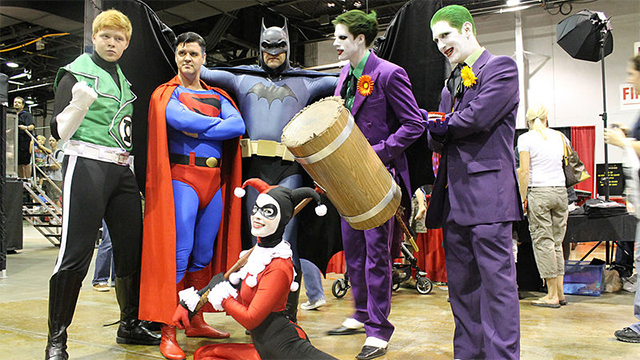Comic Conventions: Celebrating the Subculture of Comics
The first comic book convention took place in New York City in 1964 a modest gathering of just a few dozen devoted fans, held in a union hall with a single case of soda and a handful of comic collectors. That humble event planted the seed for something much bigger.WikipediaPopMatters
From those early roots, fans organized small events like Detroit’s Triple Fan Fair and the Academy Con in the mid-1960s. These early conventions were driven entirely by enthusiasts people who simply wanted to connect over shared passion for superheroes, science fiction, and the art of comic storytelling.Wikipedia Over time, many of these gatherings grew from church basements or union halls into multi-day events in full-size convention centers.Wikipedia
Growth and Transformation: From Niche to Mainstream
At first, conventions catered just to comic fans. But as comic book content spilled into film, TV, video games, and even web culture, conventions expanded too. They began to celebrate all forms of pop storytelling anime, collectible games, action figures, webcomics. What began as a niche gathering evolved into a global cultural hub.WikipediaEBSCOUniversity of Central Florida
Comic-Con in San Diego, founded in 1970, embodies this transformation. It started small but has since become the world’s largest convention of its kind, drawing over 130,000 people annually. It’s a place where creators, fans, publishers, and Hollywood all meet.Wikipedia Internationally, Japan’s Comiket focused on manga now draws over half a million visitors each year.WikipediaUniversity of Central Florida Italy’s Lucca Comics & Games and France’s Angoulême Festival are among the largest comic celebrations in Europe.Wikipedia
What You’ll Find Inside a Comic Con
Walk into a modern convention and you’re met with a whirlwind of creativity. There’s a sea of costumes cosplay is a signature feature. People dress up as characters from comics, anime, film, TV, or video games, bringing costumes to life with artistry and dedication.
Vendor halls burst with life: rows of booths cluster action figures, posters, T-shirts, art prints, and collectibles. Artists’ Alley sits nearby, offering original artwork, handmade goods, and prints directly from creators.Reddit
Panels and talks offer a range of experiences contextual, fun, sometimes promotional. Studios and publishers drop trailers or exclusive reveals. Creators share stories, fans jump in with questions, and crowds buzz with excitement.
Why Comic Cons Matter
A Cultural Launchpad
These events aren’t just gatherings they’re where excitement meets opportunity. Hollywood big-shots, comic creators, and publishers converge. Major announcements, first-look previews, and film trailers often debut at cons, setting the tone for pop culture trends.University of Central Floridasweetpaul.com
Economic Powerhouses
Conventions are economic powerhouses for host cities. San Diego Comic-Con alone brings in tens of millions of dollars in commerce. Smaller cons like Phoenix Fan Fusion still deliver strong financial boosts. New York Comic Con drives over $100 million annually into the local economy.
Community and Identity
At heart, comic conventions are community celebrations. They give fans a place where they belong. That’s especially true for people who feel isolated or different cosplay, shared fandom, pure enthusiasm create bonds.WIREDvanas.us
Driving Diversity and Inclusion
Over the years, conventions have become more diverse. Women now make up nearly half of attendees at major cons, and women-focused panels and fashion events have proliferated. Representation matters too events like Puerto Rico Comic Con, Nerdtino Expo, and others emphasize Latinx creators and fans, broadening the tapestry of voice and visibility.
Other niche cons spotlight underrepresented creators, such as Philadelphia’s East Coast Black Age of Comics Convention (ECBACC), which uplifts Black artists, writers, and stories.
Alternative and Indie Voices
Not every convention follows the blockbuster blueprint. Some celebrate small press, alternative comics, and indie creators. The Small Press Expo in Maryland welcomes only creators and publishers no retailers creating a safer space for original work and deep discovery. The Chicago Alternative Comics Expo (CAKE) focuses on graphic novels, zines, and indie art, steering away from cosplay and mainstream merchandise. Columbus’s SPACE (Small Press and Alternative Comics Expo) brings creators and fans together without distraction.
How Comic Cons Shaped the Industry
The convention circuit has shaped how comics—and entertainment—operate. One great example: Gareb Shamus took a struggling Chicago convention and turned it into a nationwide series with photo-ops, celebrity guests, and wider reach, revitalizing how fans connect. His work influenced Marvel’s renewal strategy and helped set modern fan engagement standards.WIRED
What Comes Next?
Conventions keep evolving. Events like San Diego now include independent film festivals, academic panels, and dedicated spaces for creators to connect and learn.Comic-Con International The rise of inclusive cosplay, identity-focused events, and alternative media means fans have more ways than ever to find their tribe.
Virtual versions emerged during the pandemic broadcasting panels and premieres online but they lack the energy, spontaneity, and shared magic of in-person experience. Still, online cons may continue alongside real-world events, offering accessibility without losing the core community pulse.WIRED
Comic Conventions as Living Culture
From a tiny room in New York in 1964 to massive gatherings drawing hundreds of thousands worldwide, comic conventions have become more than fan gatherings they’re cultural landmarks.
They spark ideas, drive economies, forge connections, and give voice to creators and fans from every background. Whether you’re hunting indie comics, searching for trailers, immersing in cosplay, or just soaking up the electric energy comic cons invite you to feel seen, part of something bigger, cool, creative, and alive.
References
- Wikipedia – Comic book convention history, global examplesWikipedia
- UCF Online – Growth, attendance, economic impactUniversity of Central Florida
- Wikipedia – San Diego Comic-Con facts and evolutionWikipedia
- Reddit – What you see inside a con (vendors, artists)Reddit
- JSTOR Daily – Cosplay history and contextJSTOR Daily
- SweetPaul guide – big announcements, celebrity presencesweetpaul.com
- EBSCO Research Starter – conventions as community, commerceEBSCO
- Wired/Marketing History – Gareb Shamus and industry shiftWIRED
- Time – rise of fangirls and diversityTIME
- Teen Vogue – Latinx focused conventions and representationTeen Vogue
- Wikipedia – Small Press Expo, indie focusWikipedia
- Wikipedia – CAKE, indie comics expoWikipedia

































